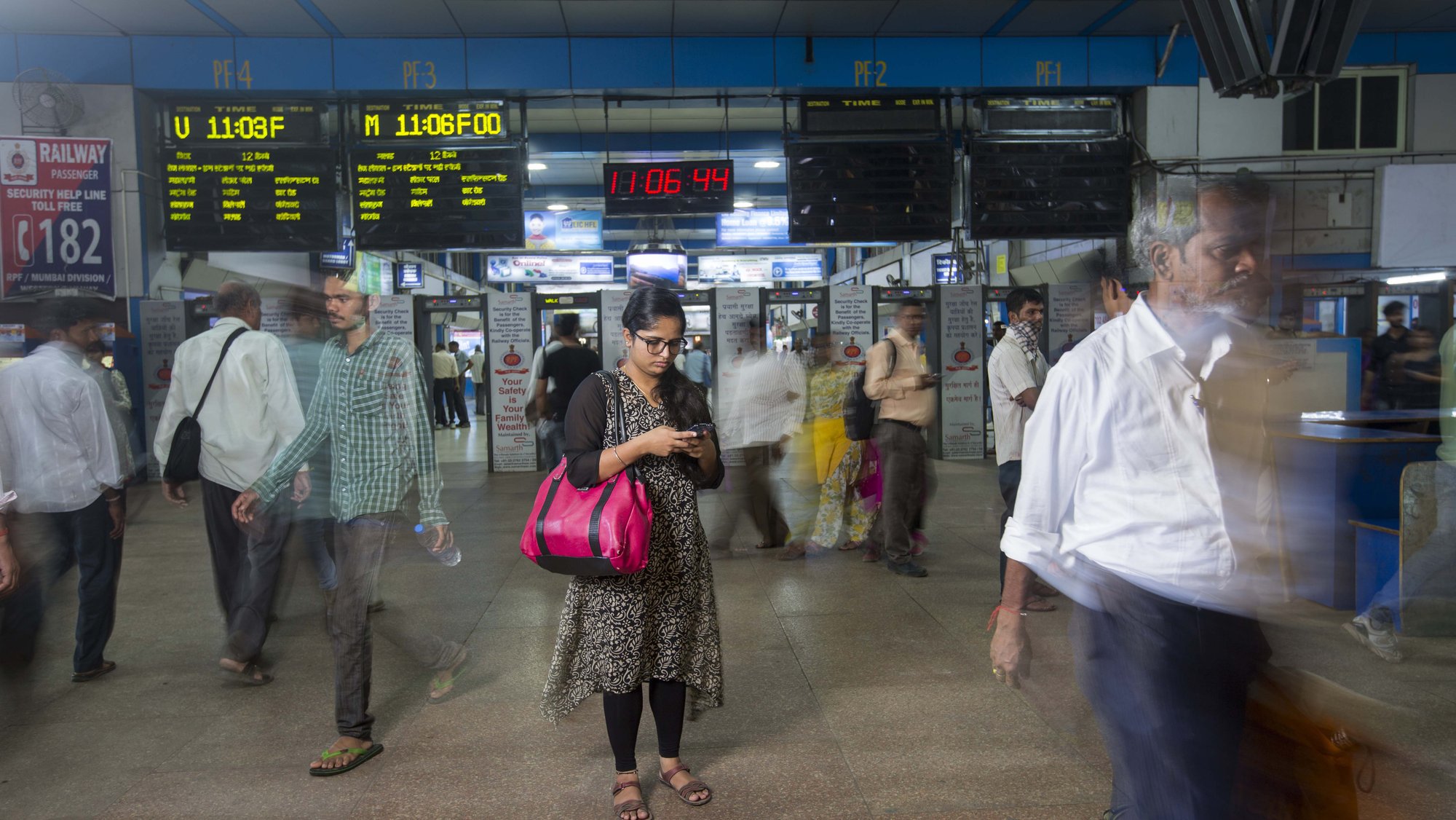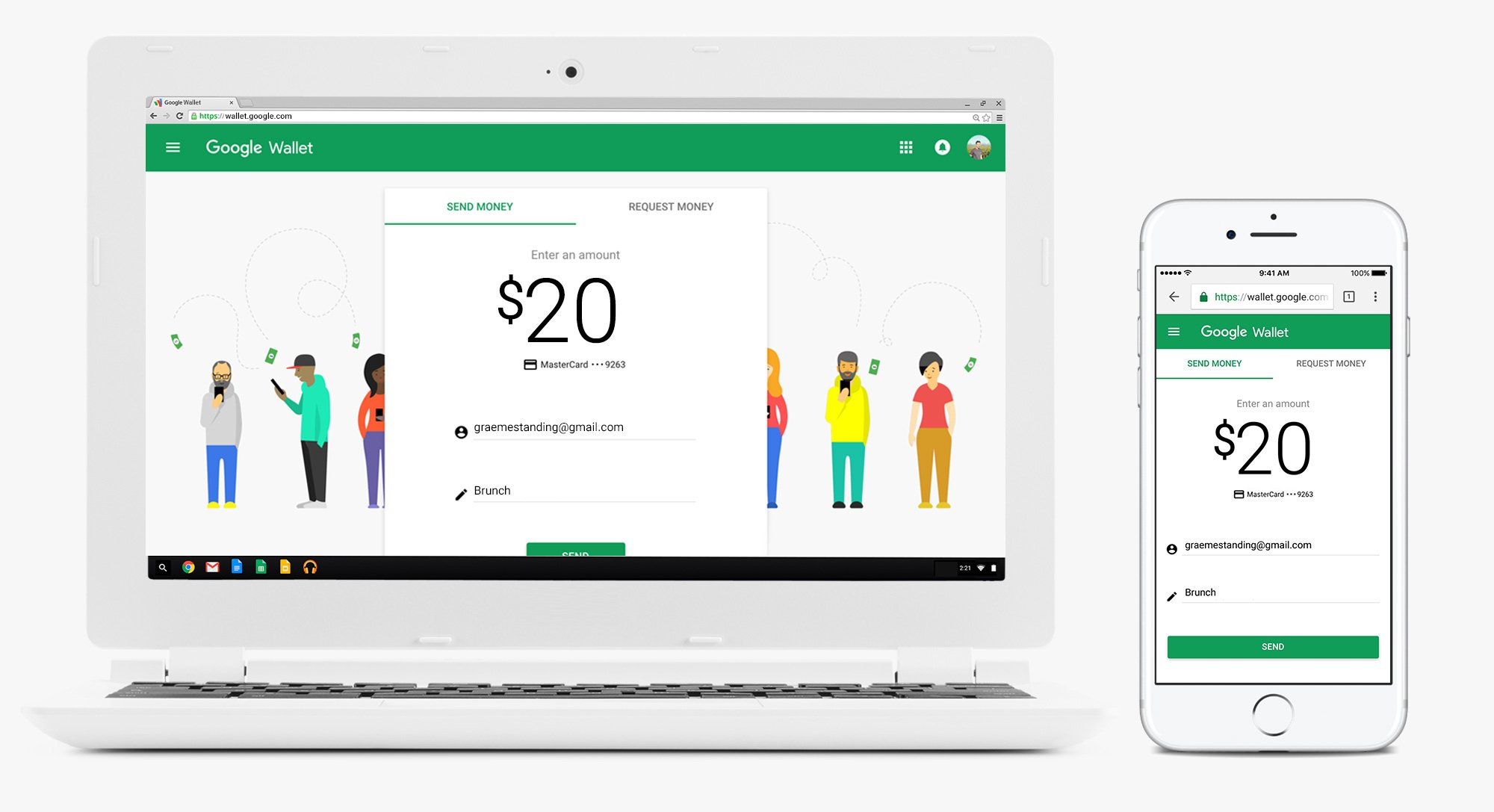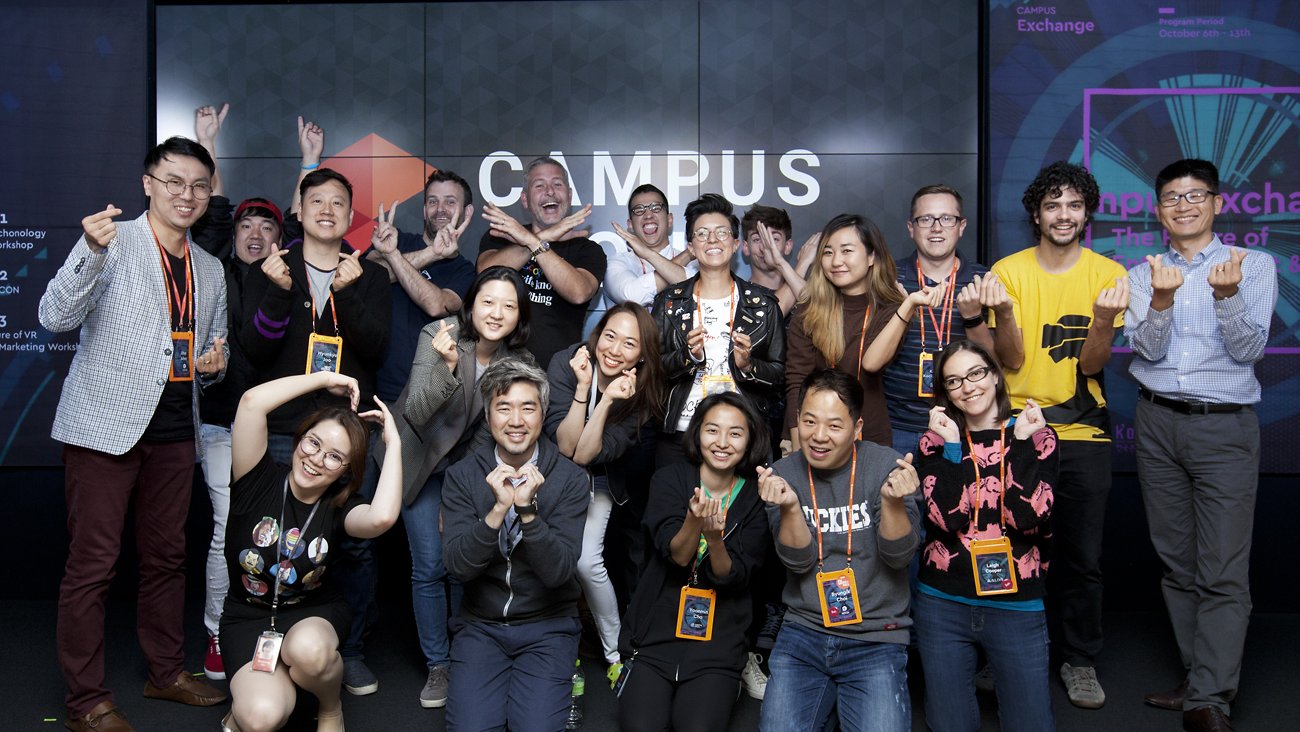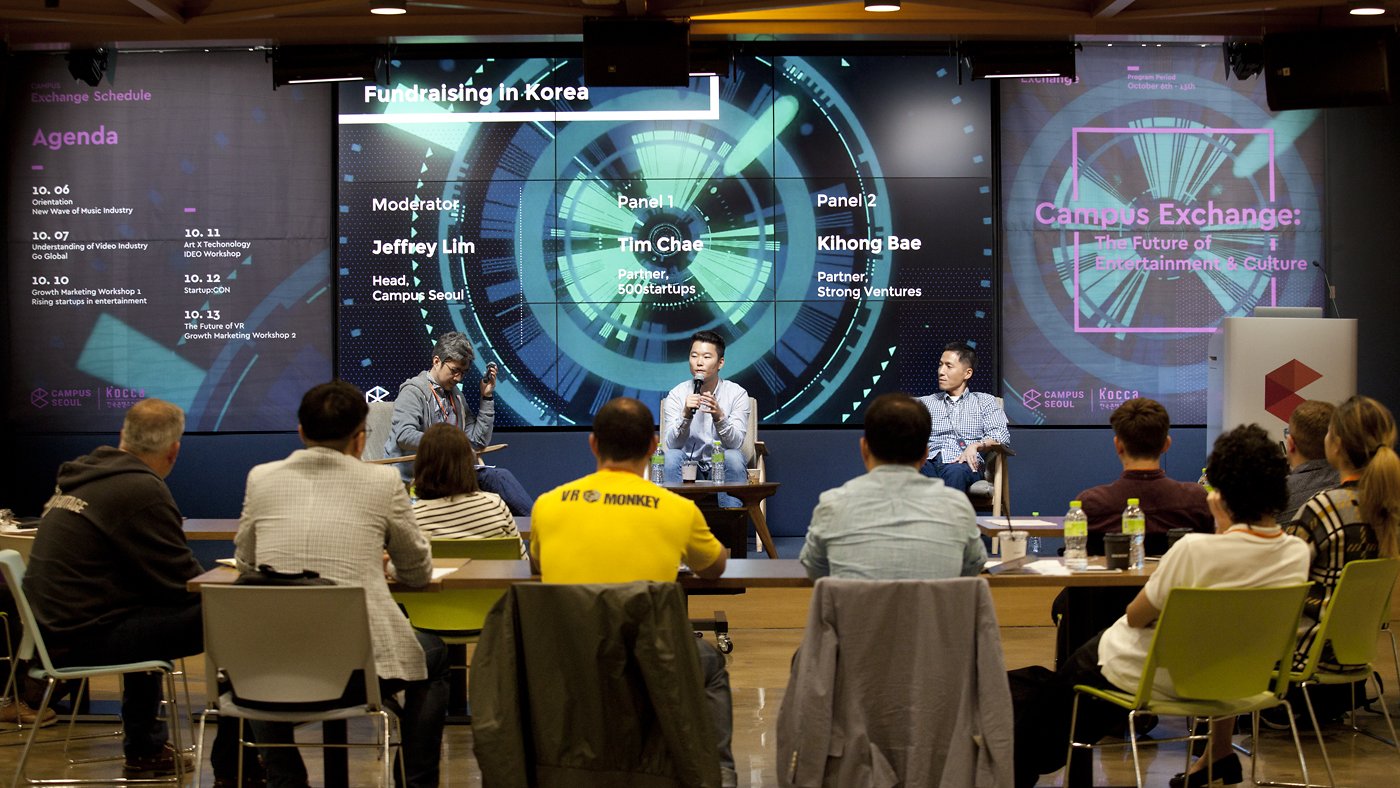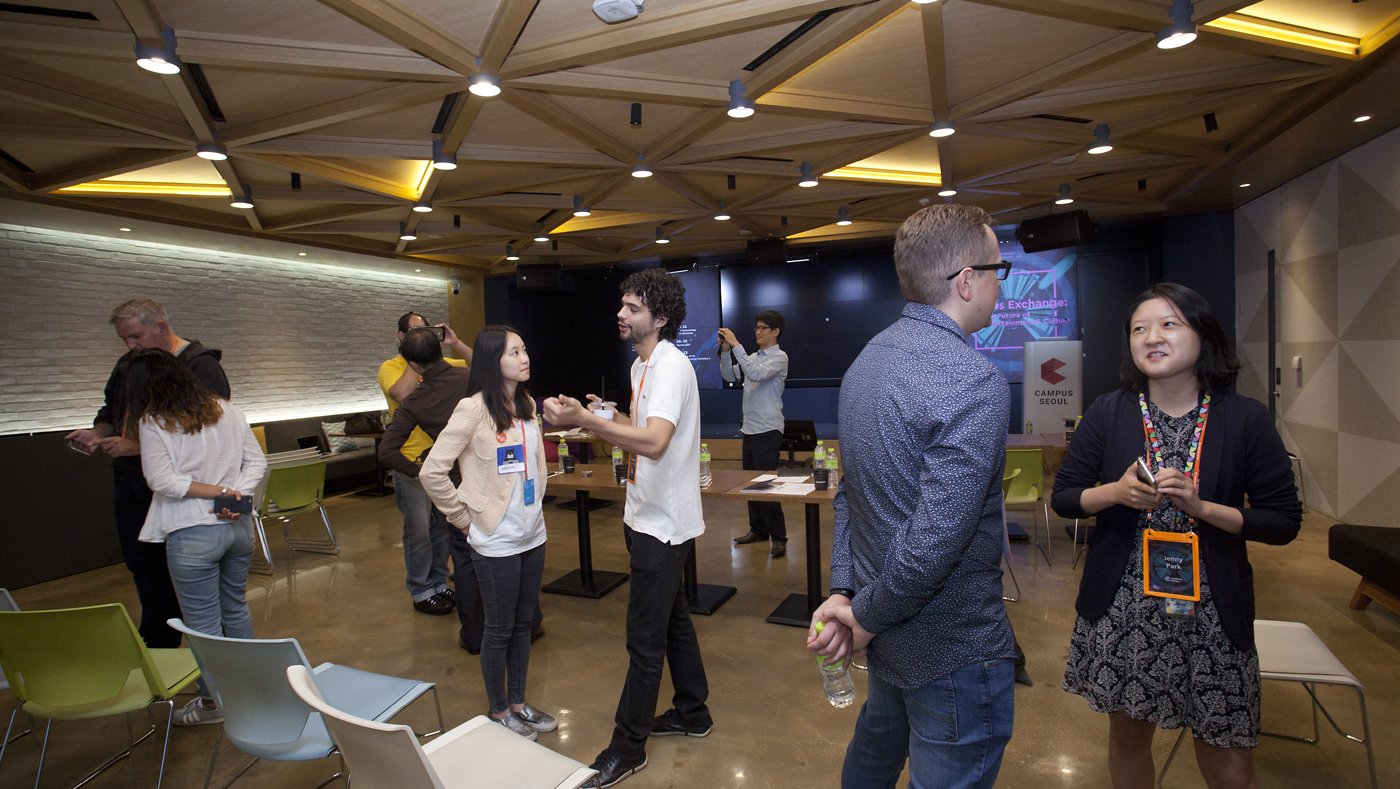The Keyword | Google Blog |
- High-speed Wi-Fi rolls into 100th railway station in India
- Supporting nonprofits around the world this holiday season
- Reflecting on Google's GNI Engagement
- Celebrating women who are making an impact at Young Women’s Honors
- Mantova, Italy's Capital of Culture 2016, on Google Arts & Culture
- Gboard, now available for Android
- A journey to the bottom of the internet
- Happy Holidays from Tilt Brush
- Introducing the new Google Wallet experience on the web
- How school superintendents explored the future of learning together
- Campus Exchange in Korea inspires start-ups’ minds, hearts and “Seoul”
- (Google) Home for the Holidays
- The Year in Search: 2016
- Bringing a virtual Pride parade to students in Bogota, Colombia
- Grain Valley School District’s new approach to 21st-century education
- Booking fitness classes just got a whole lot easier
- How BlackDog Advertising engages Statue of Liberty visitors with Chrome
- One-click software Test Drives by Orbitera, now on GCP
- Sharing National Security Letters with the public
- Upgrading SMS for Rogers customers on Android
| High-speed Wi-Fi rolls into 100th railway station in India Posted: 22 Dec 2016 03:00 AM PST 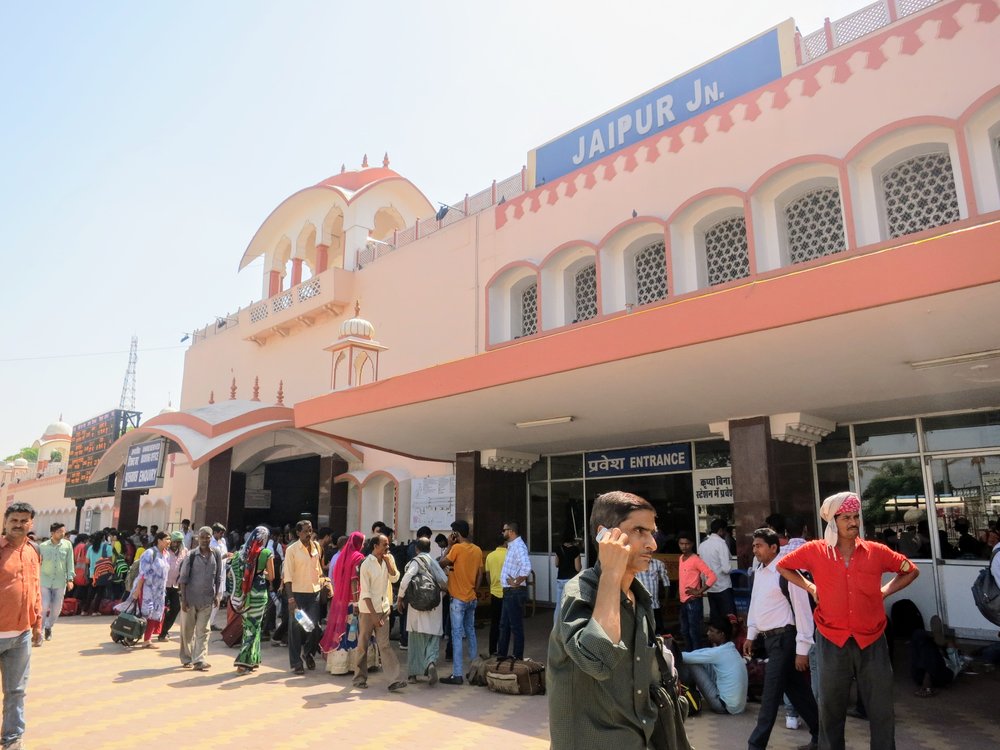 Jaipur station in Rajasthan was among the first stations to be connected to Railwire Wi-Fi. "I visit [Jaipur station] every 3 to 4 days to get fast access to the Internet. I stop there for a few minutes, download apps, update them and get things my daughter wants. She is in 10th grade and uses my smartphone in the evenings to fulfill her educational needs. She also teaches my wife, her mother, to read and write using my smartphone." This is the story of Bhagwan Sahay, whom our team met at Jaipur Railway station, one of the earliest stations to be connected to Railwire Wi-Fi this year. It's one of the many stories we've heard from people across India who are using this Wi-Fi in many ways, big and small, that improve their daily lives. With Railwire Wi-Fi rolling into Udhagamandalam (Ooty) today, we've now brought high-speed Internet to 100 of the busiest railway stations across India. That means the 10 million people (think the entire population of Sweden) who pass through these stations every day now have access to fast enough Internet to stream (or offline) an HD video, research their destination or download a new book or game for the journey ahead. And for 15,000 people, every day, these stations connect them to the Internet for the first time. 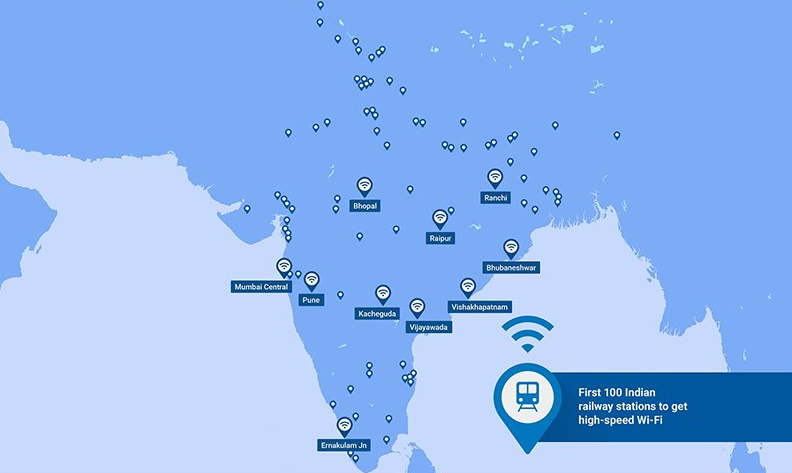 We're really excited about how far we've come since announcing our partnership with Indian Railways and RailTel to provide Wi-Fi at 400 railway stations across India. But what has really inspired us are the stories of how people, like Bhagwan, are using this high-speed access to the full and open Internet to make their lives a little bit better. Somesh Singh, an engineering graduate, has been using the Wi-Fi at Hazrat Nizamuddin station in Delhi to search the web for job opportunities and prepare for interviews. The high-speed connection helps him save money and time since he doesn't have to wait for slow-loading pages or worry about the cost of browsing. Ajay Jain, a teacher, uses the Wi-Fi to get schoolwork done on his daily commute from Indore to Ujjain, so he can spend more time with his family once he gets home. And Sandesh Awasthi, an avid cricket fan, has been having a lot more fun while waiting at Churchgate station in Mumbai, since he can now stream his favorite games to his phone in HD. 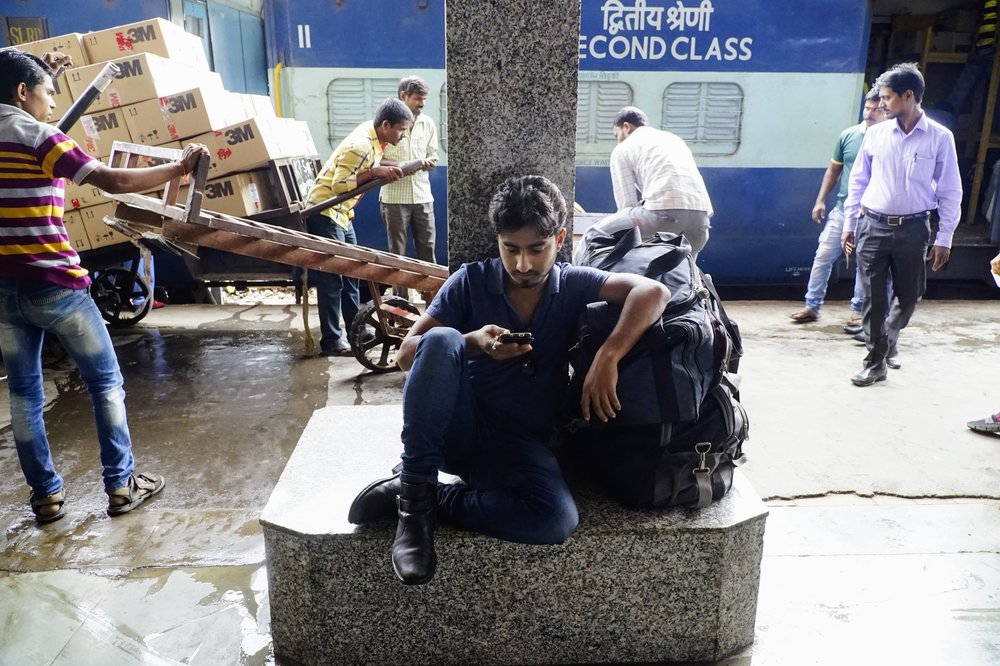 A traveler calls home while waiting for his train in Pune "I am migrant worker from Bihar and I travel to Rajasthan for work. Traveling usually means I won't have a good connection. I got so excited when I saw free Wi-Fi here at the station. I just called my wife, and the voice and picture clarity were so good. I haven't seen her face this clear in so long, whenever I talk the image is blurred because the network isn't great. She also got so excited to see my call, she was very surprised to see me. I feel so good after speaking to her. I can't stop smiling." —Bholu What's next? In September we announced Google Station, which gives partners an easy set of tools to roll-out Wi-Fi hotspots in public places. With all the possibilities that our partnership with Indian Railways and RailTel have created for 10 million Indians passing through 100 stations every day, we look forward to the many more opportunities that Google Station will open up to every Indian and the stories we hope to hear from them. |
| Supporting nonprofits around the world this holiday season Posted: 20 Dec 2016 06:00 AM PST From remote villages in India, to schools across the U.S., to refugee and migrant camps in Africa, technology can help people start a business, further their education, or access new — and sometimes vital — information. Google.org supports hundreds of nonprofits globally who are working to open up opportunities for the most vulnerable populations. As part of this ongoing work, this holiday season we're donating $30 million in grant funding to nonprofits to bring phones, tablets, hardware and training to communities that can benefit from them most. This holiday giving brings our total grant funding for nonprofits this year to more than $100 million. 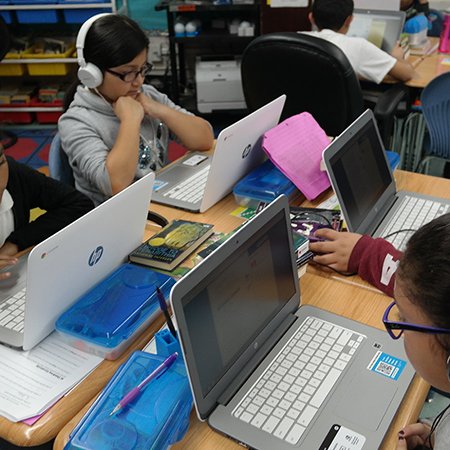 Students in Tim Jones' classroom in East Palo Alto during class time In the U.S., Google.org is supporting classrooms in need by funding projects that have requested Chromebooks and other technology via the educational giving platform DonorsChoose.org. For example, Mr. Jones, a teacher at Ronald McNair Academy in East Palo Alto, CA, where many students come from high-poverty communities, requested devices to help his students learn both inside and outside of the classroom. Our $5 million grant to DonorsChoose.org will provide more than 150,000 K-12 students across the United States — from Bunche Middle School in Atlanta, GA to Timberland Charter Academy in Muskegon, MI — with critical learning resources. We're also supporting nonprofits whose programs ensure that everyone has a chance to participate equally in society — from people experiencing homelessness to individuals disconnected from pathways out of poverty. In the Bay Area, Abode Services will help more than 1,200 re-housed homeless people receive laptop computers and related training as they move into their new homes in order to provide access to employment, social services and transportation information.  Young adults completing applications during LeadersUp hiring event in South LA Across the nation, LeadersUp will increase access to opportunities for unemployed young adults to connect to careers that lead to family-sustaining wages 350 percent above the poverty line. By providing funding for thousands of devices to assist people being served by organizations like Defy Ventures and LifeMoves, we're ensuring that more people have a fair shot at opportunity. 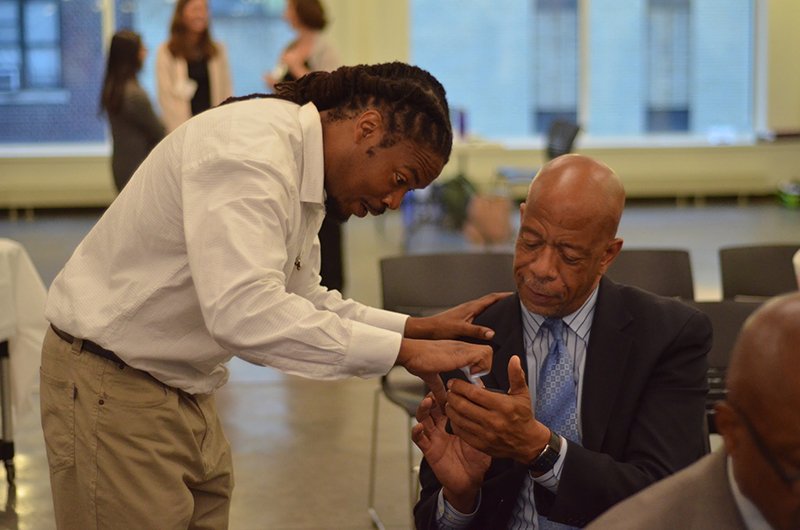 Defy Entrepreneur-in-Training Rudo C. and volunteer David R. at Business Pitch Competition in New York City 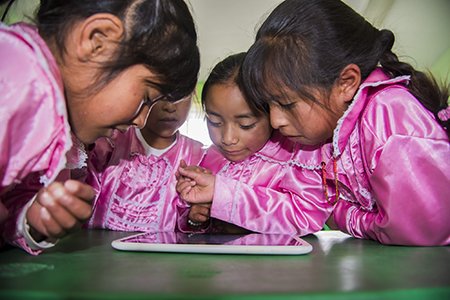 Students of Mazahua indigenous group explore learning materials on a tablet at an UNETE-supported school in San Felipe del Progreso, State of Mexico. In Latin America, we're supporting UNETE to bring computers, tablets and charging stations to classrooms across Mexico — giving students access to new curriculum materials, videos, and learning games. UNETE is committed to helping teachers be successful, and we'll pair funding for this technology with training and support services. And in India, our grant to Pratham Education Foundation will help them expand their work to help kids in rural communities learn. By using tablets across a range of their programs, from preschool through middle school, Pratham will be able to bring new, engaging content to kids and instructors. 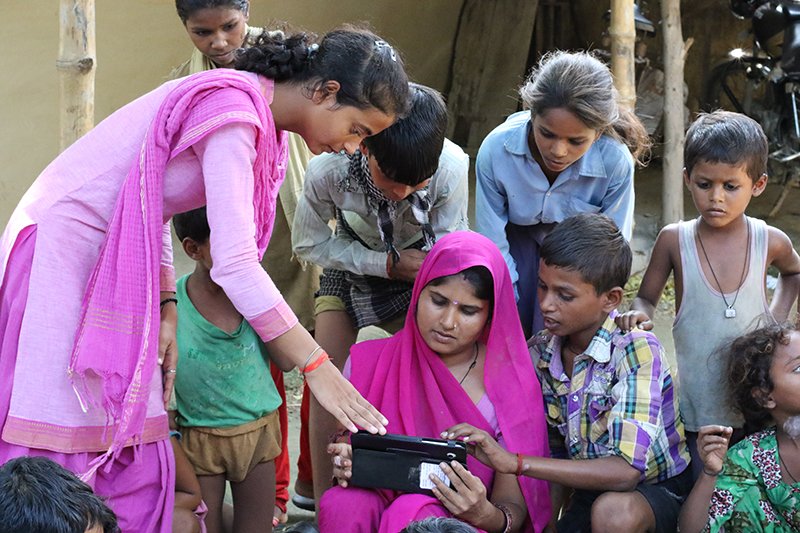 Children in Uttar Pradesh, India share what they've been learning on a Pratham-provided tablet with their family. For millions of people who have been displaced from their homes, the ability to start or continue an education can become a lifeline. As part of our refugee relief efforts, we've expanded our support of Libraries Without Borders for their "Ideas Boxes" — portable multimedia centers with Internet access and their own power source. This grant will help fund 14 additional Ideas Boxes, enabling more than 90,000 refugees to access educational resources in refugee camps in Europe and Africa. Around the world, we're funding NetHope to distribute and deliver devices through organizations working with the most vulnerable populations, including women and girls, who often struggle most to get the resources, education and opportunities they deserve. 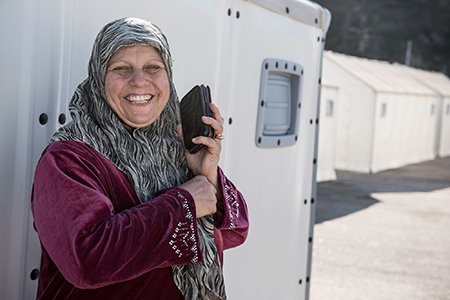 NetHope WiFi network helps refugees connect with family and friends and seek asylum In addition to these Google.org grants, every holiday season, we hold a "Giving Week" where our employees around the world can donate to the causes and organizations they want to support, and Google matches all donations. This year's Giving Week was our biggest yet. More than 50 offices participated, a third of the company pledged, Google matched, and the total impact will be $24 million to 750 nonprofits around the world. Causes ranged from supporting the victims and survivors of the Ghost Ship fire in Oakland, to helping vulnerable women in Mexico through VIFAC, to fighting hunger and malnutrition with Akshaya Patra in India. Other giving trends this year included causes like refugee assistance and transgender rights, and support for civil liberties and women's health organizations. We hope the combined $54 million in grants for technology, employee donations and Google matching will help those in need around the world this holiday season. As we look ahead to 2017, we'll continue our work to support nonprofits and communities around the world. |
| Reflecting on Google's GNI Engagement Posted: 19 Dec 2016 10:23 AM PST As the year comes to a close, we're reflecting on Google's Global Network Initiative (GNI) assessment and some of this year's important developments in our work to protect the free expression and privacy interests of our users. Last week, in our continued effort to increase transparency around government demands for user data, we made available to the public the National Security Letters (NSLs) Google has received where, either through litigation or legislation, we have been freed of nondisclosure obligations. Our goal in doing so is to shed more light on the nature and scope of these requests. We've also supported policy efforts to ensure that the privacy interests of non-U.S. persons are addressed as U.S. policymakers consider government surveillance issues. |
| Celebrating women who are making an impact at Young Women’s Honors Posted: 19 Dec 2016 10:00 AM PST What does it take to shift the conversation from "What if" to "I can"? When it comes to becoming a computer scientist, our research shows that girls need to see it to be it. Unfortunately, they're about half as likely as boys to say that they often see someone like themselves doing computer science (CS) in the media. This is why we've teamed up with Young Women's Honors — a global platform and the passion project of "Jane the Virgin" star Gina Rodriguez — which will host their first-ever award show tonight to honor and celebrate women who demonstrate confidence and leadership in their field. When you see someone following their dreams, it gives you allowance to follow your own.Gina Rodriguez Actor  Of the 10 amazing women who will be celebrated tonight, Google's Made With Code — along with YouTube star Lilly Singh and "Black-ish" star Yara Shahidi — will honor computer scientist Fereshteh Forough. After fleeing Afghanistan during the rise of the Taliban, Fereshteh followed her dreams of becoming a computer scientist. She then started Code to Inspire, a nonprofit that teaches female students in Afghanistan how to code, so that other girls from her hometown have a safe educational environment to develop their technical skills, build confidence, and challenge social norms.  Fereshteh's Code to Inspire is part of the Google RISE program, which supports not-for-profit organizations around the world working to increase access to CS education. Last week, we announced another cohort of RISE that will join Code to Inspire and 200+ organizations the program has supported since 2010. This round includes organizations from 16 countries who will reach a combined 130,000 youth from backgrounds that are underrepresented in the field of computer science. In the coming year we're excited to see what these organizations do — from girls in Argentina developing apps to solve social problems, young entrepreneurs in India building technical and leadership skills, and schools in Romania launching free coding clubs across the country. Watch the show TONIGHT at 9/8c on YouTube and The CW to meet Fereshteh and more inspiring women like her! |
| Mantova, Italy's Capital of Culture 2016, on Google Arts & Culture Posted: 19 Dec 2016 04:45 AM PST The City of Mantova, the Italian Capital of Culture 2016, unveils its story along with its finest cultural treasures and natural beauty on Google Arts & Culture. With your smartphone or computer, start exploring the wonders of the Palazzo Te: admire the lively details of the frescos of the Chamber of the Giants and use Google Cardboard to step in the room and visit all the other iconic places of Mantova, immersing yourself in its heritage in 360°. For the first time in Italy, the use of the Art Camera made it possible to bring online in ultra high resolution 50 paintings from the Palazzo's collection including the enigmatic Portrait of Giulio Romano by Titian. 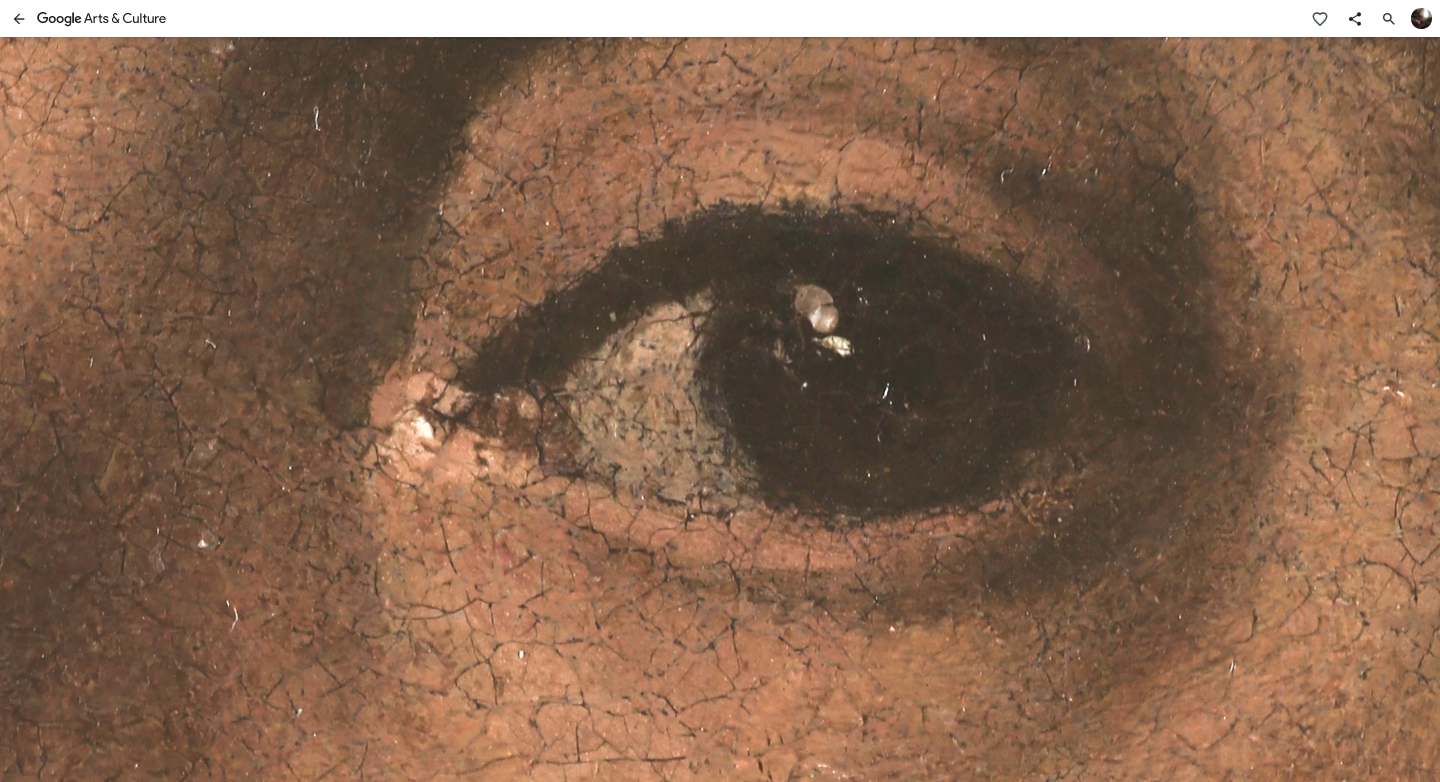 Detail of the Portrait of Giulio Romano You will be amazed by the majestic ceiling of the Teatro Bibiena, haunted by the spirit of Mozart who played the opening concert the 16th of January 1770. Leaf through the books of the Biblioteca Teresiana to find the verses of the Songbook for Isabella d'Este, a great Renaissance woman, or the illuminated pages of the invaluable manuscript from the library of the monastery of Saint Benedict in Polirone. Then, take a walk inside the Palazzo del Podestà, currently undergoing restoration, a work in progress that allows us to track the successive transformations and functions of the buildings.  The majestic ceiling of the Teatro Bibiena Yet the treasures of Mantova are not limited to the inside of its palaces. The City is itself an open-air museum inviting the user for a walk to discover its magnificent sights, its story, tradition and tastes. With the end of the year approaching, Mantova will soon pass on its title of Italian Capital of Culture to another Italian city, but its timeless artworks and wonders will remain accessible to anyone online on the Google Arts & Culture platform. Visit it at g.co/mantova2016 |
| Gboard, now available for Android Posted: 16 Dec 2016 09:00 AM PST Starting today, Google Keyboard on Android is getting a new name — and so much more. Gboard has all the things you love about your old Google Keyboard — speed and accuracy, Glide Typing and voice typing — plus Google Search built in. You can search and send information, GIFs, emojis and more — right from your keyboard. As an added bonus, we've added multilingual typing to help you switch languages on the fly. Search and share, right from your keyboard It shouldn't be that hard to search and share on your phone -- and with Gboard, it isn't. You can search Google and share results right from your keyboard — anything from flight times and weather to news. Gboard also predicts possible searches that may be relevant to you. Text a friend "Let's meet if the weather looks good" and see a prediction for "Weather". With one tap, you can share today's weather with your friend and meet up for your next adventure. 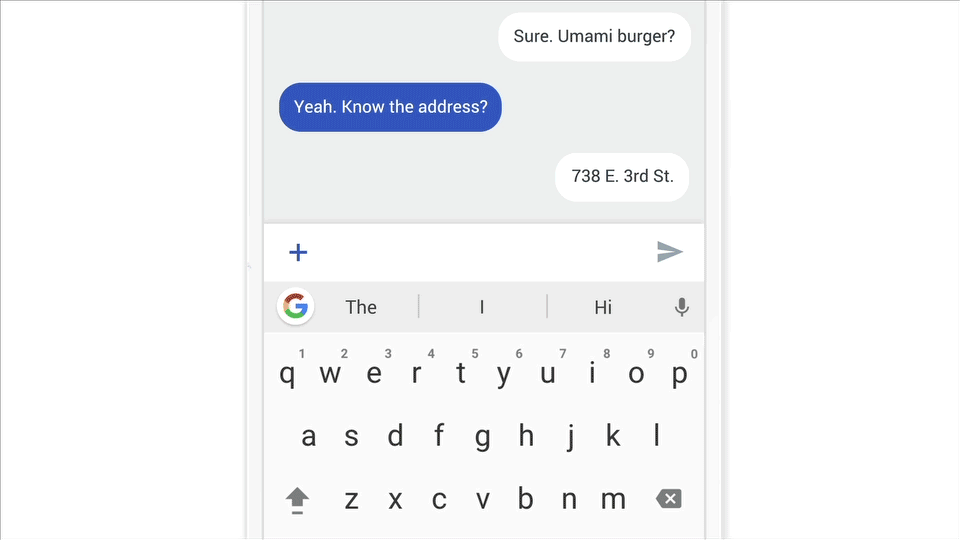 You can also search and share emoji and GIFs. Instead of scrolling and scrolling to find 🙈 or 🐒, just search "monkey" to find that emoji you want. Or, find a GIF for the perfect reaction. GIF sharing works today in Google Messenger, Allo and Hangouts, with more apps coming soon as developers add image keyboard support. So the next time you're texting a friend your favorite cat video or news of the day, you don't have to leave you app. Just search and send — right from your keyboard. Smarter and faster typing Gboard is assisted by machine learning to make typing faster and easier, including improved Glide Typing, predictions and autocorrections. And for our multilingual users, communication on a keyboard has never been easier — Gboard will now autocorrect and suggest from any of your enabled languages, so you can type in multiple languages within the same conversation without manually switching between them. Just select your languages and type.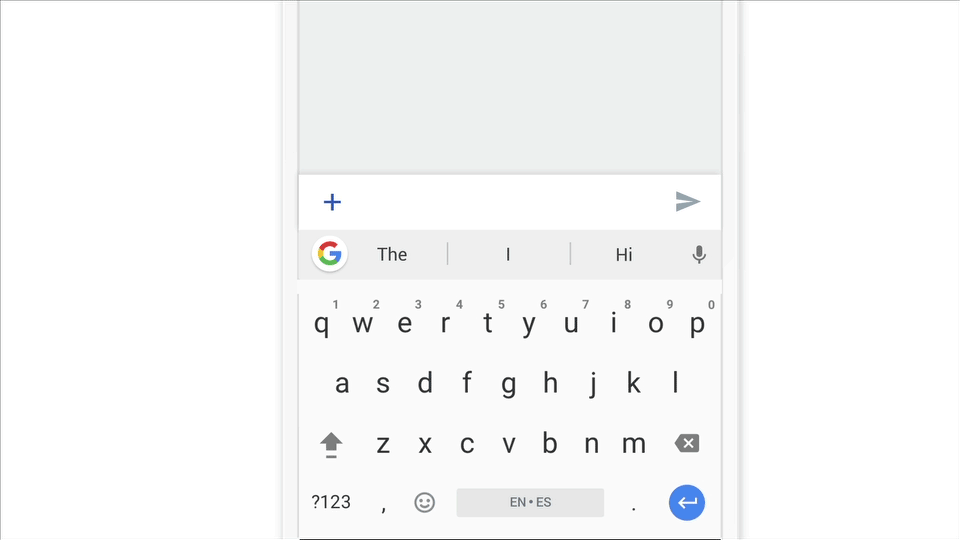 Gboard will work in more than 100 languages as it rolls out today, and will be coming to more languages over the coming months. Get Gboard from the Play Store to swipe, search and emoji away. |
| A journey to the bottom of the internet Posted: 16 Dec 2016 06:30 AM PST Depending on where you are right now, these words may have just zoomed thousands of miles, across the bottom of several oceans, at nearly the speed of light, to reach your screen. Yes. The. Internet. Is. Magic. A few of months ago, my friend Lo and I were given a challenge by the YouTube channel What's Inside. Could we get our hands on a chunk of an underwater internet cable, so they could attempt to cut it in half? We didn't know how we'd do this, but figured there was a way (lots of emails). And of course, we were excited to find the answers to our own questions about these cables in the process. Like, how many underwater internet cables are there? (More than 250 active, fiber optic cables that connect cities and data centers all over the world.) What's the history of these cables? (The first transatlantic telegraph cable is more than 150 years old.) Do sharks really bite them? (Yes, but they don't pose as big a threat as internet headlines might lead you to believe.) How much traffic can they handle? (The equivalent of 10 million YouTube videos a second.) How big are they? (Skinnier than a breakfast burrito.) Our search for a cable took us to New Hampshire to visit one of the factories that creates them, as well as aboard a ship to see the Monet cable being loaded onto it. Our trip also taught us things we never knew to ask. For example, the internet smells like a freshly paved driveway. And when these cables are loaded onto the ship, they're coiled by hand. Which means they're literally walked the entire distance that they will eventually stretch. (In the case of the Monet cable, from Florida to Brazil.) If you haven't already, please watch the video version of this story above, so you can see for yourself what a fascinating, lengthy part of the internet these cables are. And if you're curious about something else related to Google or how the internet works, I hope you'll leave me a comment on YouTube, or send me a tweet. Not only will your words potentially travel thousands of miles and to the depth of the ocean to reach me, but maybe one day, I'll get to travel to some far off corner of the internet to bring back an answer to you. P.S. We also successfully completed our mission and delivered a chunk of cable to What's Inside. To see whether or not they could cut this cable in half, check out their video. |
| Happy Holidays from Tilt Brush Posted: 15 Dec 2016 03:00 PM PST It's that time of year, happy holidays! As an end-of-year gift from the Tilt Brush team, we've got one last batch of treats for you. In our latest update, our goal is to make it even easier to create more impressive sketches… and share them with your friends. Guides: Our newest set of art tools, "Guides", allow you to create perfect shapes in Tilt Brush. Using a combination of cubes, spheres, and pill shapes, you can create everything from the solar system to a dining room chair with newfound precision. Sharing to YouTube: Once you've made a sketch, you can now quickly share a video of it to YouTube right from Tilt Brush. Just take a video and hold down the YouTube button, and you're moments away from seeing your video up on YouTube. We baked both of these updates into a tasty holiday video for you: We've also added a few of our favorites to our Tilt Brush playlist on Youtube, and we'd love to see yours too. Just tag your videos with #TiltBrush. Happy holidays and happy sharing! |
| Introducing the new Google Wallet experience on the web Posted: 15 Dec 2016 12:00 PM PST We're excited to introduce the new Google Wallet web experience (wallet.google.com) just in time for the holidays. Available across all browsers, the updated Wallet website has a brand new look and added features, which will make planning that New Year's trip with friends a breeze. You can send what you owe to your friend's email address or phone number, and they can quickly transfer the money to their bank account – all without installing an app. You can also request money on the web and your friends can pay you back without leaving their browser. Once you receive their money, you won't even need to cash out. You can just set a default payment method and any money that's sent to you through Wallet will be automatically transferred to that account. Sign in to wallet.google.com now and be sure to bookmark it for the next time you need to pay someone back. Send Money | Request Money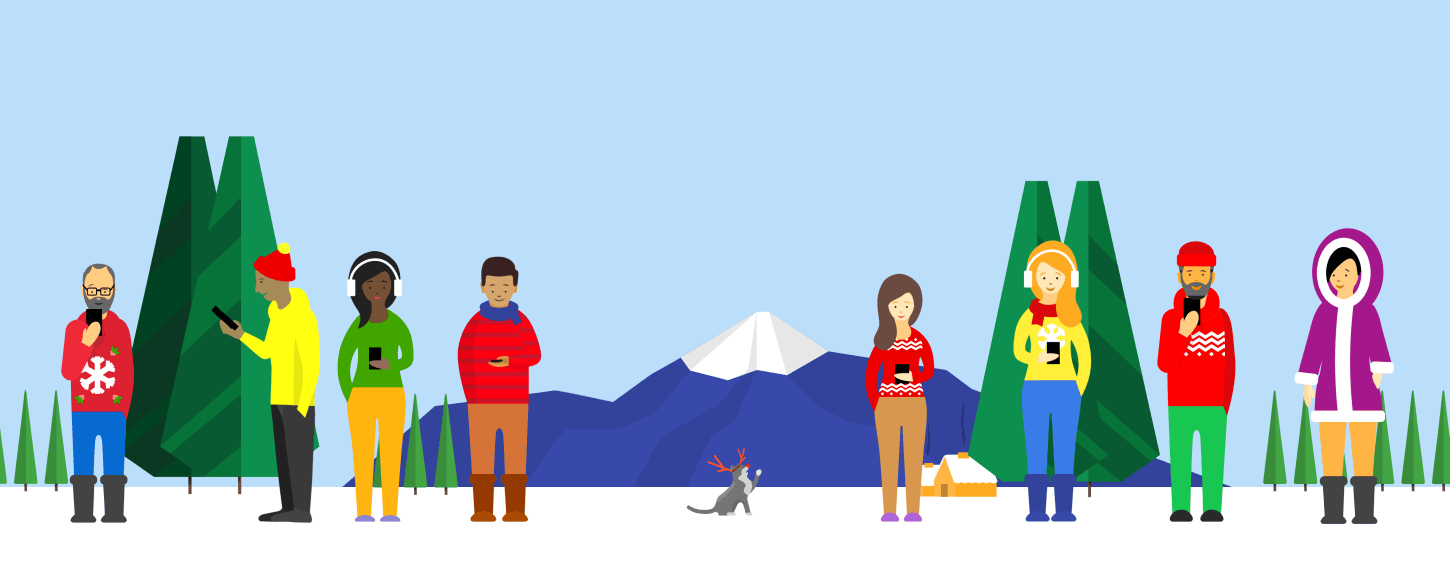 |
| How school superintendents explored the future of learning together Posted: 15 Dec 2016 09:00 AM PST As education leaders, we're expected to have all the answers. When we don't, we solve problems by talking to our peers. The School Superintendents Association (AASA) invites administrators and educators to come together and talk about the challenges superintendents face, like how best to integrate technology in the classroom. This is a focus of the AASA's digital consortium leadership cohort, which recently reached out to Google to see how they could further the AASA's goal of leading new ways to use digital media in classrooms. We also reached out to Education Reimagined, an organization that advocates a paradigm shift to learner-centered education. Google hosted a meeting of the AASA's digital consortium with Education Reimagined at Google's Chicago office in July 2016. Our discussion led us to realize we were thinking about the problem we wanted to solve in the wrong way. We had been making plans for how technology would transform our schools without considering one of the most important voices -- our students! "The group's discussion was a powerful reminder that we don't make decisions in a vacuum," said Mort Sherman, Associate Executive Director of the AASA. Putting student voices at the center of everything we do will help us design the future with them and for them. This will be a long journey for all of us, but one we are thrilled to embark on. Putting student voices at the center of everything we do will help us design the future with them and for them. Discovering student voices At the Google office in Chicago, Education Reimagined Director Kelly Young kicked off the day by emphasizing the need to put students at the center. She advocated for a student-centered approach, where learning revolves around the needs of individual students instead of traditional classroom structures. She also encouraged us to bring students to the event to make sure that student input informed all of our discussions. Google then worked with us to leverage their innovation methodology, informally known as "10x thinking" or "moonshot thinking" to help solve the challenges we were facing. It's a version of "human-centered design thinking" that helps participants develop solutions while keeping the end-user at the center of the process. 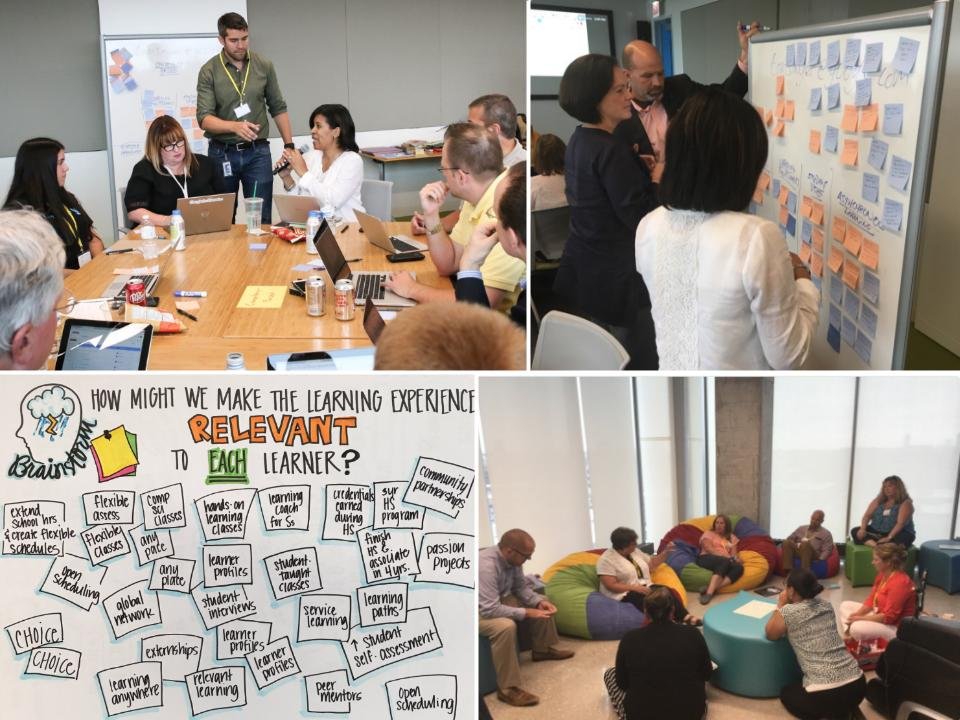 Superintendents used a design thinking process to explore learner-centered education 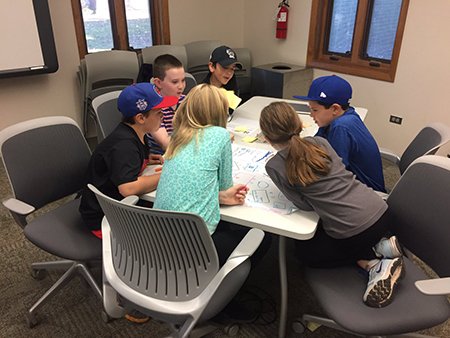 In the STAT program at Deerfield Public School District 109, students facilitate a technology review committee meeting. As we began, it occurred to us all that students are our users, and our users weren't part of our conversation as much as they should be. Without their input, we wouldn't be poised for success, because we weren't empathizing with their daily experience. By going through the 10x process with the students present, we gave them a voice in a way we rarely do. As the realization of user-centric education sunk in, we were excited to share our takeaways with our schools. After meeting in Chicago, we returned to our districts to put this learner-centric approach into action. Leyden High School District 212, for example, created two student advisory board member posts, giving students the opportunity to weigh in on meaningful decisions. Another, Deerfield Public School District 109, set up the STAT program (Student Technology Advisory Team), in which students provide their input on how technology in the classroom impacts them and what tools, devices, or practices are relevant and effective from their perspective. These are just two examples of the learner-centric transformation happening across the country. Cementing our progress More recently the AASA's digital consortium re-convened in California to discuss, among other things, how we could turn this "aha" moment into action. A huge barrier to action is getting buy-in from teachers and parents, most of whom grew up in a classroom-centric education system. Consider this: each of us spends over 16,000 hours in the classroom -- that's a lot of experience to work against. So together, we're working to develop ways for schools to pilot learner-centric education without abruptly abandoning the classroom model. Google's approach to innovation had us work through six questions in groups. We asked questions such as "If I look back in 12 months, how will I know I succeeded?" We ended the session with answers to some of the questions we had posed, bearing in mind our work isn't finished. We're still working to implement learner-centered education in schools. And it's not easy. When we meet next spring, our superintendents will report on progress made in individual schools and districts. It took combining Google's approach to problem solving, the philosophy from Education Reimagined and the amazing network of superintendents brought together by the AASA to help us think differently about the role of technology in learning. Now that we've identified the paradigm shift that needs to happen, we're excited to share our moment of realization with districts, schools, and classrooms across the country. 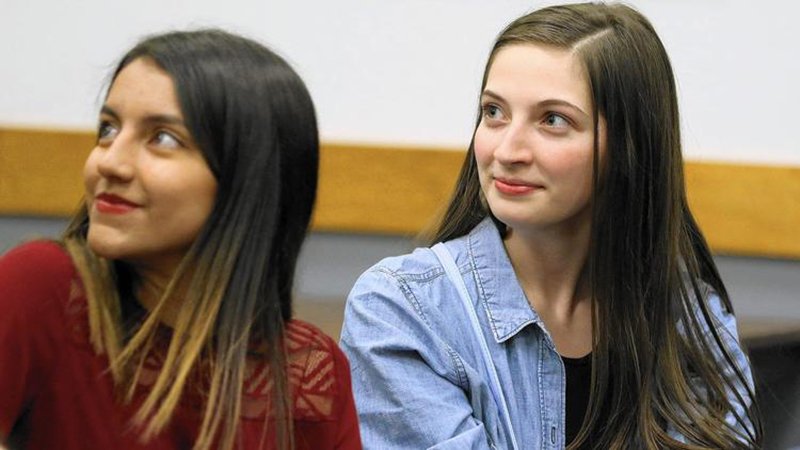 Vanessa Gallegos, left, of East Leyden and Noelle Lowther of West Leyden were introduced as student representatives for the school board during a meeting on May 12 at East Leyden High School. |
| Campus Exchange in Korea inspires start-ups’ minds, hearts and “Seoul” Posted: 15 Dec 2016 12:00 AM PST Campus Exchange is a start-up exchange program hosted by Google for Entrepreneurs. We recently invited four start-ups from Korea and another four from Brazil, Ireland, Mexico, and Poland to join us at Campus Seoul for a week. We gave them access to Startup:Con 2016, and hosted workshops on the topic of going global with their businesses. Two founders — Byungik Choi, CEO of CoolJam, the Korean start-up behind "Hum On!", an app which transforms hummed melodies into musical soundtracks, and Pedro Matsumura Kayatt, co-founder of VRMonkey, a virtual reality start-up based in Brazil — share their insights from the exchange.  What are some of the differences between running a start-up in your countries and elsewhere? Byungik of Cool Jamm (Korea): I've realized just how supportive the Korean government is of start-ups compared to some other countries. Mentors are readily available here—though I do think there's always room for more role models who are open to sharing advice about their entrepreneurial journey. Pedro of VRMonkey (Brazil): Korea has a very tech-friendly environment that helps companies to perform better and even attract more investments. Brazil's still an emerging country when it comes to technology—there aren't many big tech players, and many people with a technical background end up going abroad. 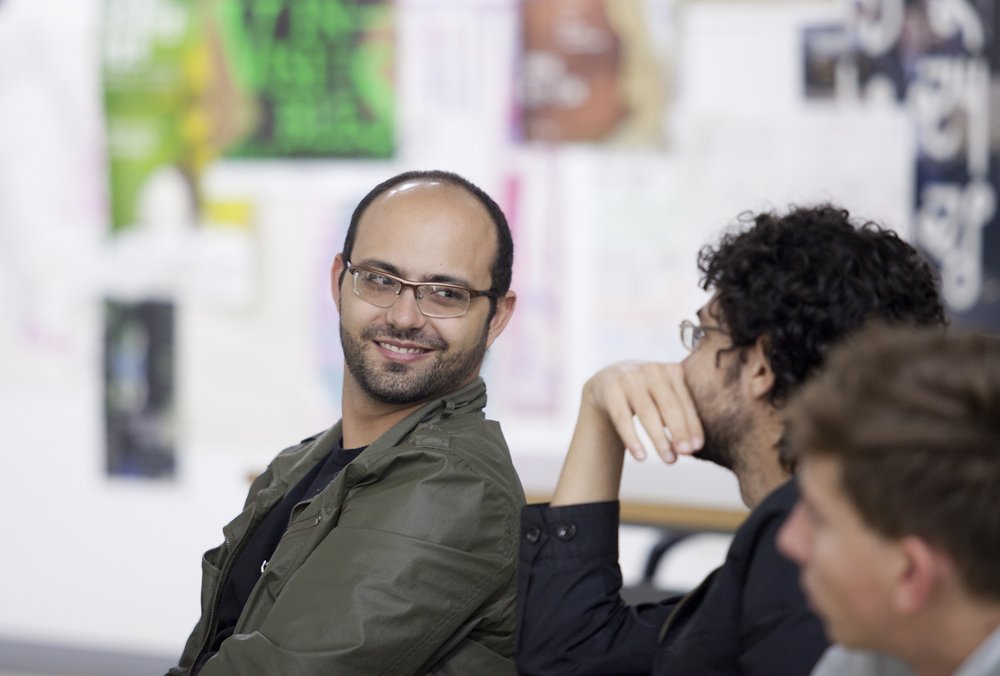 How do you think your experience at the Google Seoul Campus Exchange will shape your company? Pedro: First thing we learned is to focus. Our VR studio has been doing a lot of things, and we should really focus on doing more in one particular area. We also learned how we can collaborate better with so many content providers to create really amazing VR experiences that'll hopefully go mainstream. Second, we now understand how important it is for our projects to be accessible in other languages. English is not enough. People in Korea and other countries want to play games in their own language. Plus, we understand that we can launch games and experiences that can also impact other regions, so we are exploring more themes—including Asian themes—to create more content. Byungik: First, it reminded me of the importance of English. For a global start-up, having fluent English skills are mandatory. Second, the dogfooding session taught us that we could get a lot of meaningful feedback from Googlers and other start-up members who are from different cultures. It was really helpful. We've now decided to do dogfooding sessions frequently. Who was one of the most memorable entrepreneurs or people you met during this trip? Pedro: Wow, that is hard! I met so many amazing people during the program, but one guy who made me feel at home was Junsoo Kim, Chief Operating Officer of Reality Reflection. He invited me to their office and we spent a night there talking about the future of VR and sharing our companies' projects over a pizza! It was a great time and made us rethink a lot of things about VRMonkey. Byungik: All the participating start-ups are wonderful. FanFootage from Ireland was most impressive to me. I think it was a good example where a great idea and great technology are well-combined. And the Brazilian guys of VRMonkey were cool and friendly. What's your advice to entrepreneurs seeking to expand their business? Byungik: Staying humble. It is I who must ask for advice from other entrepreneurs because I just started my first start-up. Everything is new to me. Pedro: My strongest advice would be to share. Be honest about what you are doing, do it in the best way you can imagine, and share your work with anyone interested in it. There are few secrets and almost no competitors when it comes to markets like mobile and VR because basically, the whole world is your client. |
| (Google) Home for the Holidays Posted: 14 Dec 2016 09:00 AM PST It's that time of year. Holiday music, sweet treats, classic movies — all the reasons to cozy up and spend time at home with the ones you love. And with Google Home, there are countless ways to spread the holiday cheer. Play Netflix on your TV with the magic words "Ok Google" Serve up the holiday classics that make your season bright, hands-free, right to your TV — when Google Home is paired with a Chromecast device. Now, in addition to YouTube videos, you can stream any movie or TV series from Netflix to the TV, using just your voice*. Start with "Ok Google, play Stranger Things from Netflix on my TV" or "Ok Google, play Love Actually on Netflix on my TV". You can even control your media with commands like "Pause this episode", without lifting a finger. Here's how to link your Netflix account to the Google Assistant from the Google Home app (make sure you're running the latest version). Netflix linking in the Google Home app is available now for iOS and rolling out to Android this week. Enjoy your Google Photos on the big screen, hands-free. The holidays is the perfect time to gather around and relive memories from the year. Google Photos now works with Google Home, so you can share your photos on your Chromecast-connected TV, using just your voice. Simply say, "Ok Google, show my photos of Lake Tahoe on my TV" to see your beautiful pictures bigger. Even if you can't remember the name of the album, you can search for pictures. Try "Ok Google, show my photos of selfies at Christmas on my TV" or "Ok Google, show my photos of Brazil sunsets on Chromecast". You can even use your voice to search for your places, things and people.Learn how to link your Photos account to the Google Assistant here. 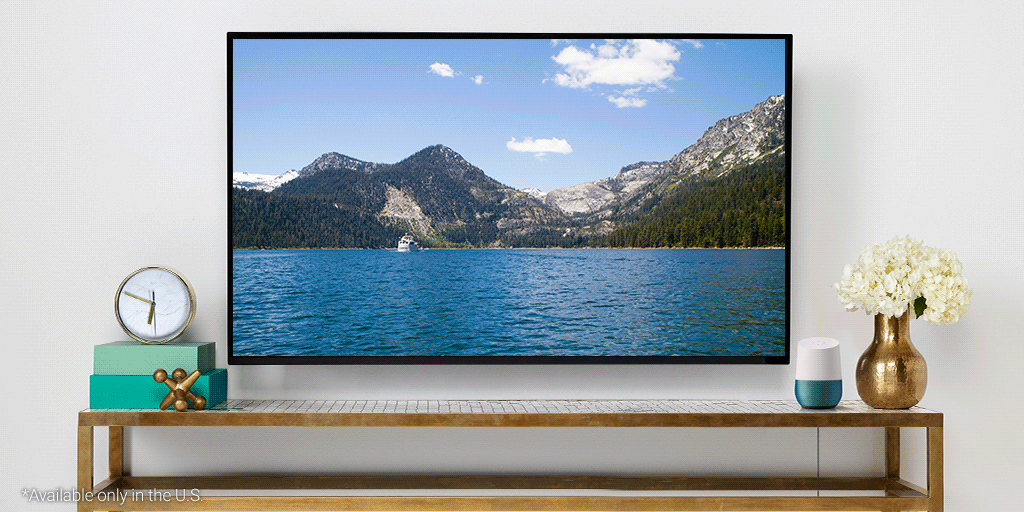 Enjoy holiday music from your favorite apps Fill your home with festive tunes from your favorite music apps like Google Play Music, Spotify, Pandora, or YouTube Music with just a simple voice command. Say, "Ok Google, play Hanukkah music" or "Ok Google, play Christmas music" and you'll get into the spirit in no time. Keep track of Santa Whether he's preparing his sleigh or already in flight, your Assistant keeps you informed of Santa's latest whereabouts (tracked by Google Maps). Just say "Ok Google, where's Santa right now?" Get YouTube Red FREE for six months Keep the holiday glow going well into the new year as you enjoy a premium music experience — more songs, more versions, no ads — with YouTube Red. Get six months free of YouTube Red when you buy a Google Home before December 31, 2016**. Make your holidays truly magical with Google Home.*Netflix streaming membership required **Offer expires 12/31/16. Terms apply. New subscribers only. |
| Posted: 14 Dec 2016 12:00 AM PST It's that time of year — when we look back at the last 12 months and reflect on the trends that defined the year in Google Search. From Powerball numbers to Olympic champions, whether making dessert or becoming a mannequin, this year affected us all in different ways. Through all the highs and lows, people came to Search to learn more and understand. So to celebrate the end of 2016, here's a peek at some of the trending U.S. topics that caught our attention as especially unique to this year.
These are just a few of the trending terms that made up 2016. From remembering past icons like David Bowie and Prince, to searching for current ones like Beyoncé and Alexander Hamilton (a.k.a. Lin-Manuel Miranda), to looking for information on Brexit, Zika, Orlando and Brussels, Search brought us together in dozens of ways this year. Dive into google.com/2016 to see lists from around the world. Here's to finding what we're searching for in 2017. |
| Bringing a virtual Pride parade to students in Bogota, Colombia Posted: 13 Dec 2016 01:45 PM PST Editor's note: Earlier this year, we launched #prideforeveryone, a global virtual reality Pride parade that anyone, anywhere could join. Since then, we've distributed Google Cardboard and the virtual Pride experience to more than 20 groups and nonprofits, worldwide. This is the story of Alba Reyes, founder of the Sergio Urrego Foundation, who brought the parade to students in Bogota, Colombia. In 2014, my son Sergio took his own life because he was suspended and discriminated by his school for kissing another boy. Unfortunately, neither I nor his friends were able to prevent the harassment and isolation he felt. Since then, I've made it my mission to make sure what happened to Sergio doesn't happen to any other young person in my country. I started the Fundacion Sergio Urrego to travel to schools across Colombia and lead inclusion workshops with local students. Although LGBTQ children may be more likely to feel isolated, many young people don't feel accepted by their families, friends or teachers. My workshops create activities and safe spaces that help students understand how it feels to be discriminated against – reinforcing the importance of diversity and inclusion. An important part of these workshops is helping students put themselves in another person's shoes. This summer, we used Google Cardboard to give students in my workshops a way to experience Pride parades from across the globe. Most of these students have never seen a LGBTQ Pride parade. But with virtual reality, they can learn more about the global LGBT community, and feel supported by a global community that celebrates diversity. Celebrating Virtual Pride in Bogotà, Colombia #prideforeveryoneAfter seeing the impact of my workshop and virtual Pride parade on children in Colombia, institutions like the Ministry of Information and Communication Technologies have have showed their support to scale my workshops to even more children across the country. My fight is not just for my child. It's for all children who have endured discrimination and bullying from their peers, teachers and community. If you'd like to join Alba, teachers, and community leaders around the world in bringing this virtual reality experience to your group, you can use this discussion guide created by one of our Google Educators. Interested in creating your own #prideforeveryone lesson plan based on the 360 film? Share your lesson on TES, the world's largest online community of teachers |
| Grain Valley School District’s new approach to 21st-century education Posted: 13 Dec 2016 01:00 PM PST Editor's note: As part of the ExploreEDU event series, schools are working with Google for Education Premier Partners to throw open their doors and invite neighboring educators to learn first-hand from their own experiences using Google tools to innovate and improve. To see if there is an event near you, visit the ExploreEDU site. For those who can't join in person, we'll also share the schools' experiences here. Today's guest author is Nicholas Gooch, Director of Technology, from Grain Valley School District. The school is hosting an event on Dec. 15-16 with Best Buy. It's daunting to realize that many of us are preparing students for jobs that don't yet exist and a world we can't quite imagine. At Grain Valley School District, we've designed our schools to prepare students for the future workplace. We've created our curriculum to emphasize communication and creativity. We've done away with the traditional 100-point grading system to instead focus on helping students master their subjects. We've even started the process of redesigning our high school campus to create dedicated spaces for group and individual learning. We see technology as critical to helping students master the skills they'll need in the 21st-century workplace. We began integrating technology into everyday learning by launching G Suite for Education at our high school, two middle schools and four elementary schools during the 2014-15 school year. Last year our high school became the first of our schools to go 1:1 with Chromebooks. Each of our 1,250 high school students has access to a Chromebook that they can use in class and at home. With the help of technology and the support of our innovative teaching staff, here are a few ways we changed how we educate to better prepare students for the future: Fostering teacher leadership and innovation To empower our teachers to push the envelope and take more risks with technology in the classroom, we created Breakthrough Learning cohorts. The cohorts are made up of elementary and secondary teachers who applied for the program. One day each month, these teachers work with our instructional technology coaches to learn the best practices for integrating technology into their curriculum. These sessions go beyond typical "how-to" sessions and instead focus on helping teachers make learning, assessment, and digital citizenship a seamless component of the classroom. Not only does the program develop this capacity in our own teachers, it allows them to do the same for their fellow teachers.  High school students using TV screens to collaborate on shared assignment. Emphasizing subject-mastery over grades In 2006, school and district leadership reexamined the 100-point grading system. They decided to try a new approach — helping students achieve subject mastery rather than measuring them on a graded scale. Standards-based grading and feedback practices have been fully integrated at the high school since the 2013-2014 school year. Today, we personalize each student's learning program. Google Classroom has also helped us emphasize the learning process rather than a final grade. Teachers can easily give feedback on an assignment, even before a student has turned it in. Building for collaboration The new architecture for our high school is designed to make it easier for students to study together outside of class. We're creating communal spaces with whiteboard walls and TV screens. Students can use these TV screens to visualize projects they're working on together — for instance, a presentation they've made in Google Slides. We're also providing WiFi access and ample charging stations for laptops and mobile devices across the campus. Over the next few years we hope to introduce similar changes to other schools in the district.We're excited to be hosting an ExploreEDU event on December 15-16. If you're in the area, join us to hear more about how we redesigned our approach to teaching and learning for the 21st century, supported by technology and an openness to change. |
| Booking fitness classes just got a whole lot easier Posted: 13 Dec 2016 11:00 AM PST After a holiday season full of delightful indulging, millions of people make an optimistic New Year's resolution to stay fit or lose the extra pounds they put on from those festive parties and family get-togethers. To help, starting today we're piloting a new way to easily book fitness and wellness classes. Reserve with Google will be available in Los Angeles, New York City and the San Francisco Bay Area, to make keeping up with your resolutions easier than ever. To book a fitness class, visit the Reserve with Google site on desktop or mobile web. There you can search for fitness studios near you, get great recommendations for fun new classes, or book a spot in the session you already know and love. 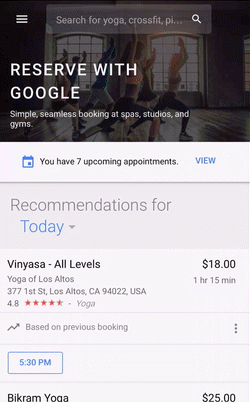 Over the coming days, you'll be able to do this right from Google Maps and Google Search, as well. 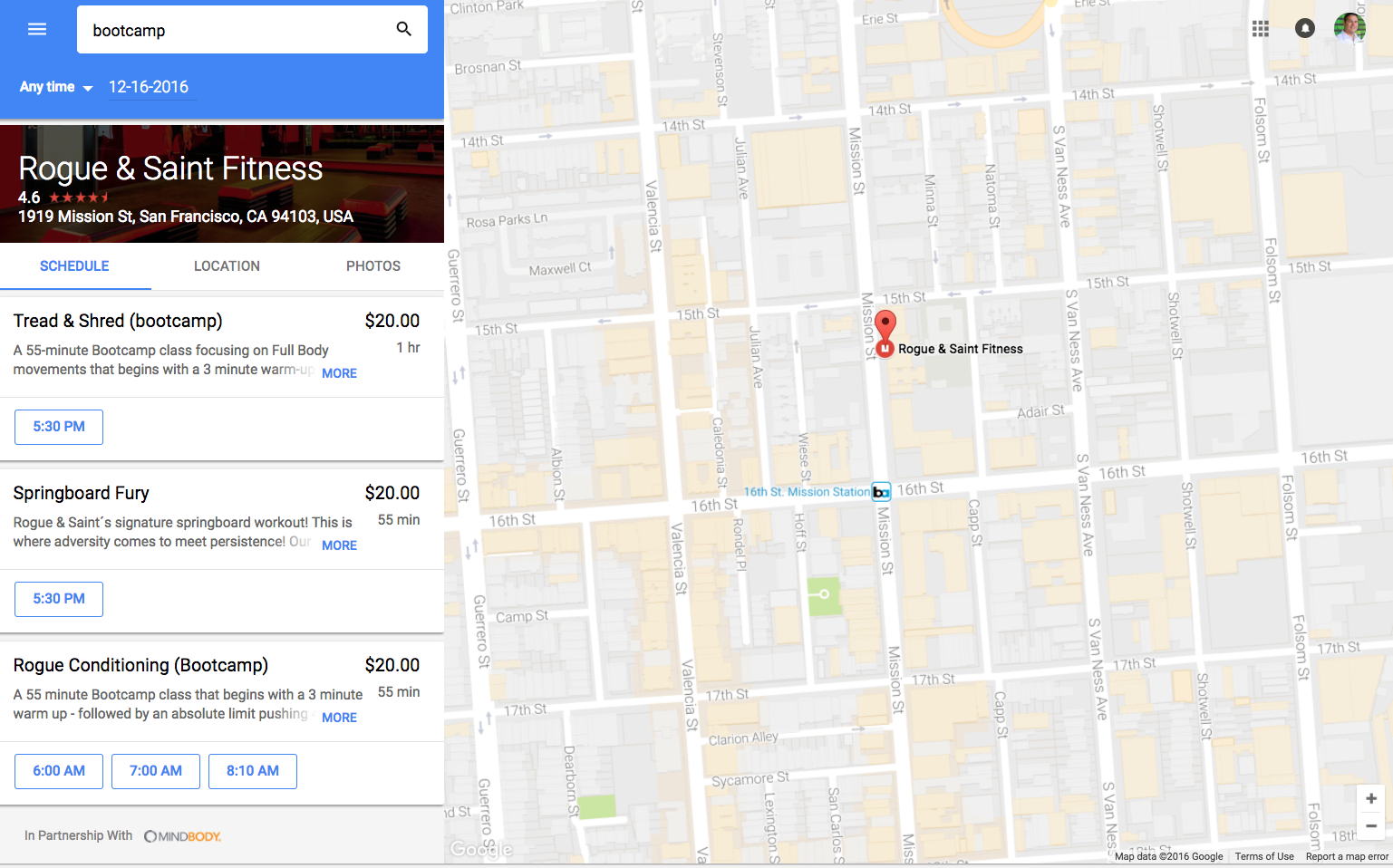  Reserve with Google is possible through deep partnerships with top scheduling providers you may already use, including MINDBODY, Full Slate, Front Desk, Appointy — and we'll be adding more, like zingFit, MyTime, and Genbook soon. So pull out your yoga mat, dust off your running shoes, and fill up that water bottle. Reserve with Google will help make completing your New Year's resolution as easy as click, click, booked. |
| How BlackDog Advertising engages Statue of Liberty visitors with Chrome Posted: 13 Dec 2016 11:00 AM PST Editor's note: Today we hear from John W. Penney, creative director and CEO of Miami-based BlackDog Advertising. Read how the company used Chrome devices to build engaging signage for Evelyn Hill, a vendor on New York City's Liberty Island. The Statue of Liberty towers 300 feet above Liberty Island, where visitors can admire its grandeur and explore the history leading to its construction. While most people know some of the statue's history, few know Evelyn Hill, the family-owned business that has been selling food, refreshments and souvenirs beneath the Statue of Liberty for three generations. We took on the challenge of transforming Evelyn Hill's gift shop and restaurant, the Crown Cafe, into a visitor destination, and driving traffic to thestatueofliberty.com. Evelyn Hill wanted to replicate a photo contest my company, Blackdog Advertising, had created for Dry Tortugas, a remote national park off the Florida coast. This time, we'd be creating a live photo feed so visitors could see images as they were uploaded. My company had a great experience using Chrome devices before, so we decided to use Chrome digital signage devices because they are easy to deploy, cost effective and make content management a breeze. 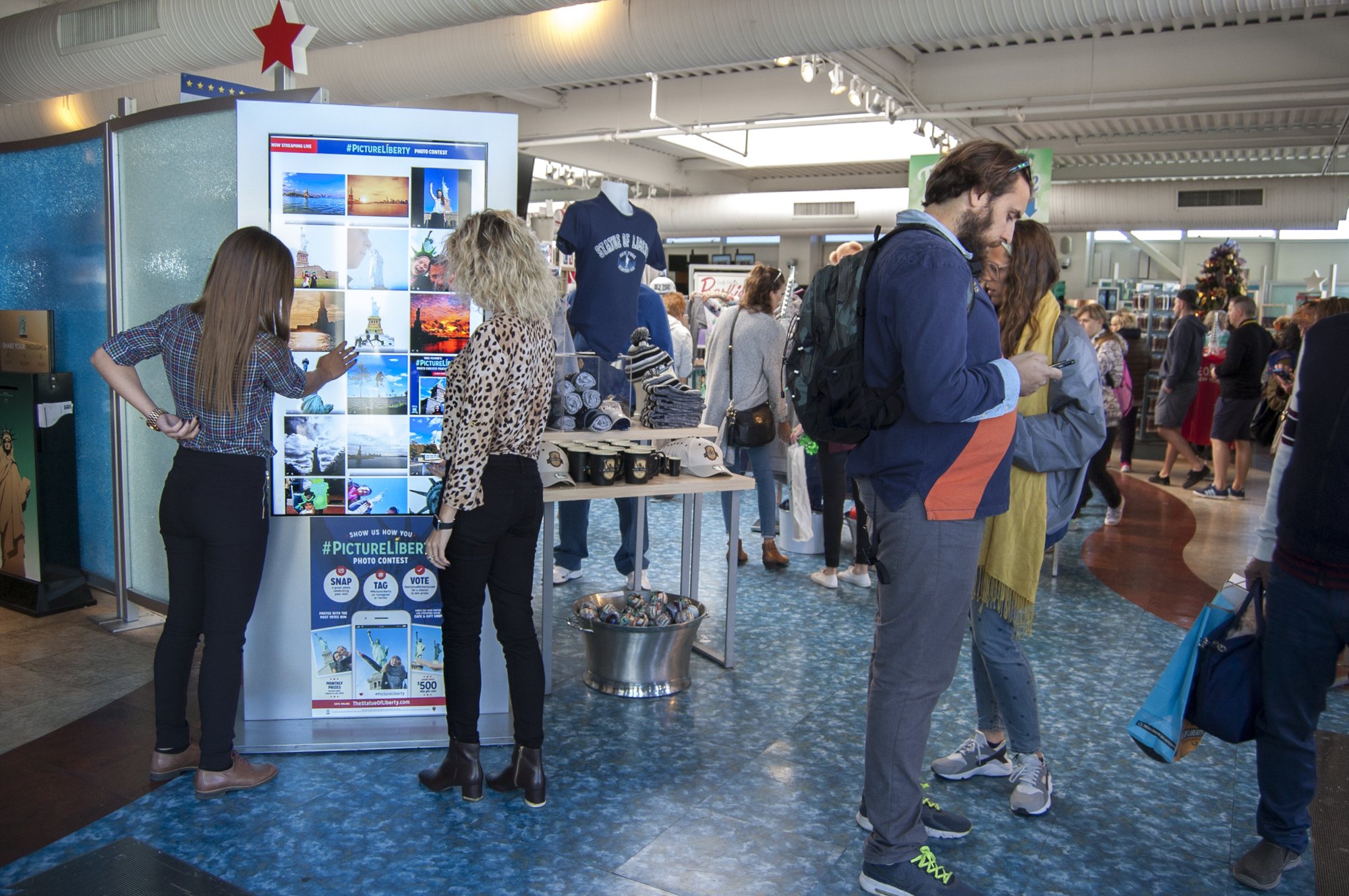 The photo contest has driven incredible engagement — both in person and online. Over 21,700 photo votes have been cast so far, and thestatueofliberty.com saw a 270 percent traffic spike as a result. Evelyn Hill is considering ways to expand the photo contest to other locations on the island because of the success we've seen so far. To drive high engagement, we created live-updating digital signs to draw visitors into the Crown Cafe and engage them in the photo contest. Monitors are powered by Google Chromebits that are remotely operated using Chrome Device Management, so the cafe can easily display contest results. Meanwhile, visitors can use the #PictureLiberty hashtag to share their photos on the Statue of Liberty website and encourage their friends to vote for their submission. The flexibility of Chrome lets us optimize signage solutions. With Chrome Device Management we were able to easily install WooBox, which collected contest photos from social media, on all of our managed devices (in this case, Chromebits). We don't want to deliver cookie-cutter solutions to our customers, and Chrome enables us to build solutions that stand out from the crowd. Using Chrome also helped keep the campaign cost effective. Since Chrome Sign Builder is free to use and the photo content is user-generated, hardware was the only cost. Each of Liberty Island's four units cost just $109, including access to Chrome Device Management, which allowed us to easily install apps on the Chromebits. Achieving this low cost would have been impossible with any other digital signage solution. Visitors remember their time on Liberty Island for the rest of their lives, and Evelyn Hill is part of that experience. Chrome helps make that experience better. The #PictureLiberty contest and others like it will ensure the Crown Cafe remains a visitor destination for decades to come. |
| One-click software Test Drives by Orbitera, now on GCP Posted: 13 Dec 2016 10:00 AM PST Since joining the Google Cloud team in August, we've been hard at work bringing Orbitera to Google Cloud Platform customers and partners. Today, we're excited to announce that Orbitera supports Test Drives that run on GCP and we've completed a successful Test Drive beta that includes software providers like Barracuda, DivvyCloud, Looker, and Vormetric. Thanks to the support of our partners and great team we continue to provide immediate value to customers looking to experience third-party solutions on GCP. Orbitera Test Drives are fully functioning and interactive software demonstrations offered on the cloud. This is a popular way for businesses to try software before buying it — no software license, credit card or even cloud account required. At Orbitera we make it easier for businesses to try, buy, deploy and manage complex software in the cloud. One-click Test Drives empower businesses to try software before buying it, and comprehensive consumption billing management gives corporate IT unprecedented visibility and control. Here's what some leading software providers had to say about their Orbitera Test Drives on GCP:  Looker is a Data Platform that makes it easy for everyone to find, explore and understand the data that drives their business. "First impressions are very important, and that's why we chose Orbitera Test Drives to increase lead-to-deal conversions. Trying a fully-functional instance of Looker's Analytics Platform with just a few clicks and no procurement or deployment hassle is a great introduction to Looker." - Keenan Rice, VP, Alliances at Looker  Vormetric's comprehensive high performance data security platform protects data wherever it resides with transparent encryption, powerful access controls, and centralized key management. "Comprehensive solutions like ours can be a challenge for prospective customers to get up and running in a test environment, making it hard for them to really get to know the product and its capabilities. With an Orbitera Test Drive on GCP, customers can get a fully functional environment in minutes, and that makes for a very favorable first impression and gives our sales team a real head start on closing the deal." - CJ Radford, VP, Cloud at Vormetric  DivvyCloud's BotFactory is a simple point-and-click tool for users to configure, build and deploy bots that automate cloud management tasks. "We've worked with some of the leading cloud adopters in the world to solve common cloud problems through automation of policies. We're very excited to bring this solution to the broader market through our bot system in BotFactory. This Test Drive will show customers how they can connect a cloud account to BotFactory and find and fix these cloud problems in a matter of minutes." - Jeremy Snyder, VP of Business Development at DivvyCloud, creators of BotFactory Test drive Orbitera today See how easy it is to try full-stack software with Orbitera — take a Test Drive for yourself. Try Looker and BotFactory by DivvyCloud, and come back soon for more Test Drives by leading software providers. Google Cloud Partners: for a limited time, we're running a promotion to let you create, operate, and run a Test Drive of your software on GCP at no cost for up to one year. Follow this link to sign up. |
| Sharing National Security Letters with the public Posted: 13 Dec 2016 10:00 AM PST In our continued effort to increase transparency around government demands for user data, today we begin to make available to the public the National Security Letters (NSLs) we have received where, either through litigation or legislation, we have been freed of nondisclosure obligations. We previewed this back in October when we updated our Transparency Report. As we have described in the past, we have fought for the right to be transparent about our receipt of NSLs. This includes working with the government to publish statistics about NSLs we've received, successfully fighting NSL gag provisions in court, and leading the effort to ensure that Internet companies can be more transparent with users about the volume and scope of national security demands that we receive. In 2015, Congress passed the USA Freedom Act, which allowed companies like Google to make more granular disclosures about National Security Letters they receive. In addition, the Act restricts the use of indefinite gag restrictions that prevent providers from ever notifying customers or talking about the demands. The Department of Justice (DOJ) must now regularly review disclosure restrictions in NSLs and lift those that are no longer needed. The United States Attorney General approved procedures to do this, and as we mentioned recently, the FBI has started lifting gag restrictions on particular NSLs. We are now making copies of those NSLs available. Our goal in doing so is to shed more light on the nature and scope of NSLs. We minimized redactions to protect privacy interests, but the content of the NSLs remain as they were when served. We are also publishing the correspondence reflecting the lifting of the nondisclosure restrictions. We have links to the documents below. In the near future, we will establish a more permanent home for these and additional materials from our Transparency Report. Redacted NSLs and FBI correspondence While we are encouraged by this development, we will remain vigilant in opposing legislation that would significantly expand the universe of information that can be obtained with an NSL. |
| Upgrading SMS for Rogers customers on Android Posted: 13 Dec 2016 06:00 AM PST Many of us rely on SMS every day — to make plans, confirm an appointment, or stay in touch with friends. But even as smartphones have become more powerful and the apps we use on them more vibrant, SMS hasn't changed a lot. It's still just plain text. We believe this standard messaging experience should be better, so through a mobile industry initiative called RCS (Rich Communications Services), we've committed to working with carriers and manufacturers to upgrade SMS to a more enhanced messaging experience for people everywhere. Last month, we announced our first carrier supporting this richer messaging experience. Now we're bringing RCS to even more people by working with Rogers Communications to launch RCS messaging to their Android customers in Canada. Rogers customers will have access to enhanced features — including group chat, high-res photo sharing and read receipts — as part of their standard messaging experience on Android. You can access the upgraded messaging experience by downloading the Messenger app for Android devices from the Google Play Store, and the service will be powered by the Jibe RCS cloud. We're beginning to roll out the enhanced messaging experience today, and it will be available to all Rogers customers soon. 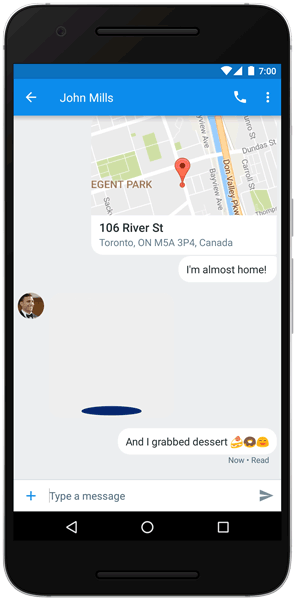 Next year, Rogers intends to preload Messenger as the standard messaging app for new Android devices. We're excited to provide a better messaging experience to Canadians, and look forward to launching RCS with more partners in the coming months. |
| You are subscribed to email updates from The Official Google Blog. To stop receiving these emails, you may unsubscribe now. | Email delivery powered by Google |
| Google Inc., 1600 Amphitheatre Parkway, Mountain View, CA 94043, United States | |

